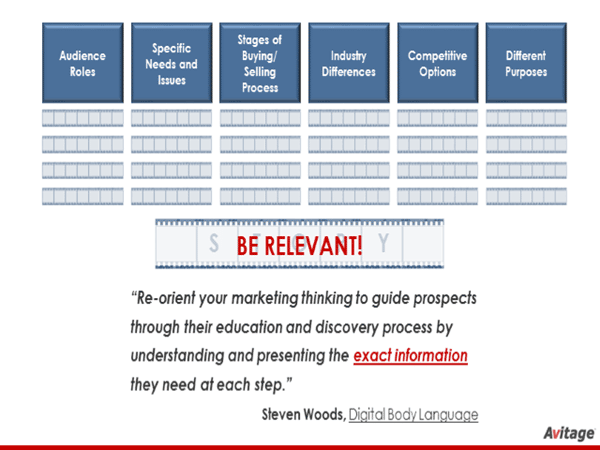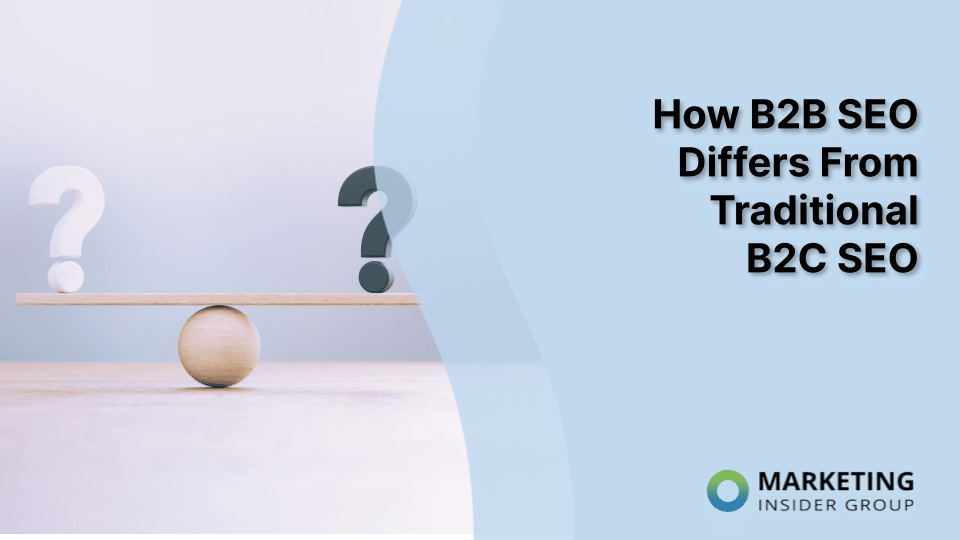
Content Creation: Modular vs. Structured & Traditional
As content marketing practices mature, organizations look for new ways to gain advantages and improve content performance.
One of the most elusive tactics is to optimize content for audience and situation relevance. Numerous studies have shown business outcomes improve significantly when content delivers highly targeted, useful and relevant insights to audiences.

Yet marketers currently struggle to produce content tailored even to relatively simple relevance factors, such as specific industry verticals or personas. Demand campaigns and nurture tracks seldom are targeted to those factors. Lack of data, list segmentation and relevant content are three primary reasons we usually hear.
As marketers move beyond content for marketing tactics, and step up to support sales and the sales channel’s content requirements, the ability to deliver highly targeted, situation-relevant content will be an essential capability.
Sales engagement is essentially a one-to-one activity. When B2B buying teams are made up of 5 to 6 stakeholders, the specific issues of the buying team is the “one.” If content isn’t relevant and useful to the specific issues of the buying team, it won’t have much impact.
Unfortunately, the traditional, “bespoke,” custom creation approach simply can’t meet this requirement. It’s not fast or flexible enough. The common adage is “good, fast or cheap, pick any two!” It can’t scale without compromising quality, time or costs.
Structured Content Approach
In search of alternatives, advanced content marketers have investigated an approach referred to as “Structured Content.”
“Structured content is information or content that is organized in a predictable way and is usually classified with metadata. XML is a common storage format, but structured content can also be stored in other standard or proprietary formats.” Wikipedia
This is a specific approach within a broader concept called Intelligent Content.
“Intelligent content is a strategic communications business asset:
Content that is “intelligent” is not limited to one purpose, technology or output. It is structurally rich and semantically aware, and is discoverable, reusable, reconfigurable and adaptable. It is ultimately one of the most strategic assets that a company can have.” Intelligent Content Conference
Structured Content creation has been used by the technical publication profession for over a decade. It’s based on a structured database, similar to the way some website content management systems (CMS) work.
This approach typically uses XML content storage methods. DITA (Darwin Information Typing Architecture) is a common methodology that is used by software authoring systems. Content is written into and pulled from a formerly-structured database of content components.
Modular Content Approach
The nature of today’s B2B marketing and sales content has shifted from product data sheets, to more educational and story oriented content. This content represents the largest and fastest growing segment for content marketers.
Unfortunately, the Structured Content approach and it’s systems are generally too rigid and difficult for most marketing and sales users.
Marketing and sales content is also more dynamic, in a less structured way than technical publications, or even websites.
A modular content approach may provide a better alternative to meet the challenge of creating many versions of finished content to optimize for contextual relevance.
Primary version categories include:
- Situational context
- Audience type (prospect, customer, influencer), industry vertical, buyer role or persona
- Specific topic interest
- Business purpose
Shared and reusable modules improve content quality and consistency. Another example is the need for greater adaptability. A specific module might fit well in one asset or context, but in another context requires modification. Source modules that reside outside a structured database can more easily be edited for context.
Modular Content as “Core” and “Extensions”
A modular content approach involves creating common “core” elements as source modules. Core modules contain important or common messages that are used across many assets, use cases and even business functions such as sales, marketing and training.
Other modules provide contextually unique “extensions” to core elements. Extensions are custom elements that surround core components. They are not as universally re-usable as core elements. Extension components can created within business functions that are closest to audience, business purpose and situational context.
Configured Assets
The ability to create custom “Configured Assets” is especially helpful. This is the ability to configure core and extension modules into a new asset. It might also require some asset-specific custom language.
Here’s an example of a Configured Asset. We’ve identified at least 10 content criteria that content operations must meet and ideally optimize. These criteria add to pressure to scale output. Meeting these criteria can lead to high-performing, long-life content assets. It also results in higher return-on-content investments than the traditional approach.
The Configured Asset linked above is comprised of four modules:
- 10 criteria list
- video
- graphic
- explanation at bottom of why these are issues.
Each module is used as a stand-alone asset. They are also used in different combinations in several Configured Assets.
Consider a scenario where you want to optimize a white paper or e-book for relevance based on three business problems, four primary industry verticals and three key buyer personas and (a rather common scenario).
While it initially sounds daunting, a configurable modular content approach makes it eminently practical and achievable to assemble source modules into 36 versions of final work products!

Update and Maintain Long-life Assets
Traditionally, when content elements are physically copied into many different versions, they become “hard coded” to each asset. Another possibility with a configurable modular content approach is to have modules that are configured in many versions retain connection to their source module.
When feedback indicates the need to edit source modules, all versions that use the module are automatically updated. There’s no need to know which versions contain or require the updated sections. Even previously delivered assets can reflect updated changes.
For example, in the linked configured asset above, the video is periodically updated. It syncs from Wistia, our video hosting service, through the modular content component, into different configured versions. This can also apply to editing lists of text, or replacing graphics.
For a large portion of digital content requirements, simple configured assets are suitable enough for rapidly deployed content and regular use. Where higher production values are required — higher design and formatting for example — configured versions can simply be exported into a high-end design application as part of a finishing process.
Business Impact of a Modular Content Approach
Content creators today work under increasing pressure to deploy finished assets quickly, to meet short time-frame requirements, or test new ideas and messaging. Modular content creation, management and configuration enables faster content time-to-market.
A configurable modular content approach also means content can be maintained over time to preserve quality, extend useful life, and raise ROI.
But the most significant business impact is realized as a result of the ability and flexibility to scale output while optimizing relevance versions. Relevance today equates to quality. As the white paper example above indicates, exponential increases in output can be realized without significantly increasing time, resources or costs.
Becoming facile with modular content is a critical competency for operating a leveraged content supply chain.






